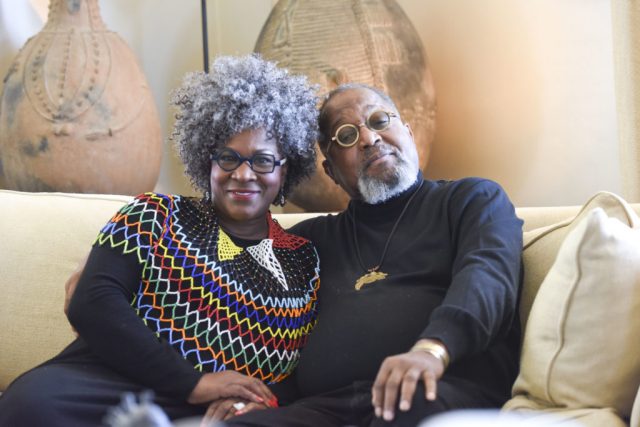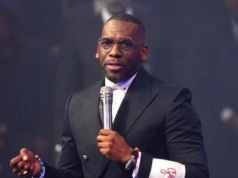By Javacia Harris Bowser
For the Birmingham Times
When the iconic American modernist painter Jacob Lawrence came to Birmingham in 1994, local art collector Elias Hendricks was filled with excitement.
“Lawrence was a legend,” Elias said of the artist, who died in 2000. “He’s a national treasure, so if he’s coming to town and I get a chance to meet him, I’m just geeked!”
At the time, Elias and his wife, Gaynell, were a part of Birmingham Museum of Art (BMA) organization that was focused on bringing more Black and African art to the museum and to the city.
Twenty-six years ago, the BMA presented “Jacob Lawrence: The Migration Series,” the artist’s highly acclaimed collection chronicling the mass movement of African Americans from the rural South to industrial cities in the North. Lawrence and his wife, Gwendolyn Knight, who was also an accomplished artist (she died in 2005), traveled to Birmingham for the opening of the exhibit. The Hendrickses got the opportunity to help the Lawrences tour the Magic City.
“Jacob Lawrence: The American Struggle,” a captivating exhibition of Lawrence’s paintings from the series “Struggle … from the History of the American People,” will be on display in the BMA’s Jemison Galleries from Nov. 20 through Feb. 7, 2021. Painted between 1954 and 1956, this series presents Lawrence’s reinterpretation and reimagining of key moments from American history in a way that highlights the pivotal role of women and people of color in shaping the nation.
Lawrence’s work hasn’t been on display in Birmingham in more than a quarter century, but Elias believes the renowned painter’s art is now more relevant than ever. The city and the nation are in a moment of great change that includes correcting historical narratives. As proof, Elias points to efforts like the New York Times Magazine’s “1619 Project.” This ongoing project developed in 2019—400 years after the first enslaved Africans arrived in the Virginia colony—seeks to reframe American history by centering on the consequences of slavery and the contributions of Black Americans.
“It’s only right that one of our greatest artists, who spent his life chronicling and making real the history of this country, be included in this revolution,” Elias said. “Jacob Lawrence, like Michelangelo, is always relevant.”
Magic City Tour
During Lawrence’s 1994 visit to the Magic City, the Hendrickses took the artist and his wife to Sixteenth Street Baptist Church to pay homage to the four little girls killed in the 1963 racially motivated bombing; they also toured the Birmingham Civil Rights Institute.
“He was very impressed with Birmingham and how beautiful it was,” Elias said, adding that Lawrence wished more artists captured the joy of Black people in Birmingham.
“When all of that was going on, we still lived and flourished as a Black community,” Elias said.
The Hendrickses made the noted artist’s visit a family affair—and not just for their own family. At the time, the couple owned a day care center. In preparation for Lawrence’s visit, children at the center read “The Great Migration: An American Story,” a children’s book based on Lawrence’s paintings from “The Migration Series.” The kids then created their own works of art about their families. The Hendricks couple compiled the children’s artwork in a book to present to Lawrence when he stopped by the day care center during his visit.
“He was really moved by that,” Gaynell said. “He cried, and he hugged every child there. He was such a warm gentleman. He was like a grandfather.”
Despite his fame in the art world, Lawrence was humble and easygoing, Gaynell remembered: “When you were talking to him, he was all yours.”
“Gracious … Friendly”
At the time of Lawrence’s 1994 visit, Gail Andrews was the BMA’s acting director. She said of the artist, “He was gracious, positive, friendly, open, and he had a great sense of humor. He and Gwendolyn both were so easy to be with. You didn’t feel awkward around them.”
The BMA’s “Jacob Lawrence: The Migration Series” exhibition was a hit.
“The opening was so packed I couldn’t move,” said Andrews, who retired from her position as director of the museum in 2017.
For Andrews, the most memorable moment of Lawrence’s visit happened during an event reserved for sponsors of the exhibit. A woman arrived at the museum and said, “I know this wasn’t my night to come, but I wanted my grandson to meet Mr. Lawrence,” Andrews recalled, fighting back tears.
“She took [the boy] over to Lawrence and said, ‘Son, you are meeting a great man,’” Andrews said. “It just opened my eyes to what Lawrence did with those works of art of his and the story he was revealing.”
Lawrence’s work isn’t just about trials and tribulation, it’s also about triumph. Just as “The Migration Series” captured the beauty of family life, the “Struggle” series—though depicting scenes of conflict—can evoke a feeling of hope.
“You can’t look at a Lawrence painting without feeling something,” Elias said.
Andrews believes that, just as Lawrence himself was, the works are awe-inspiring yet still accessible.
“There is an abstract quality to the very innovative way he uses color, but it’s still a narrative that everybody is welcomed into and that we understand,” Andrews said. “That’s not easy to do, but [Lawrence] did it.”
“Jacob Lawrence: The American Struggle” opens at the Birmingham Museum of Art on Friday, Nov. 20, 2020; the exhibit will be on display in the museum’s Jemison Galleries through Feb. 7, 2021. For more information, visit artsbma.org.





